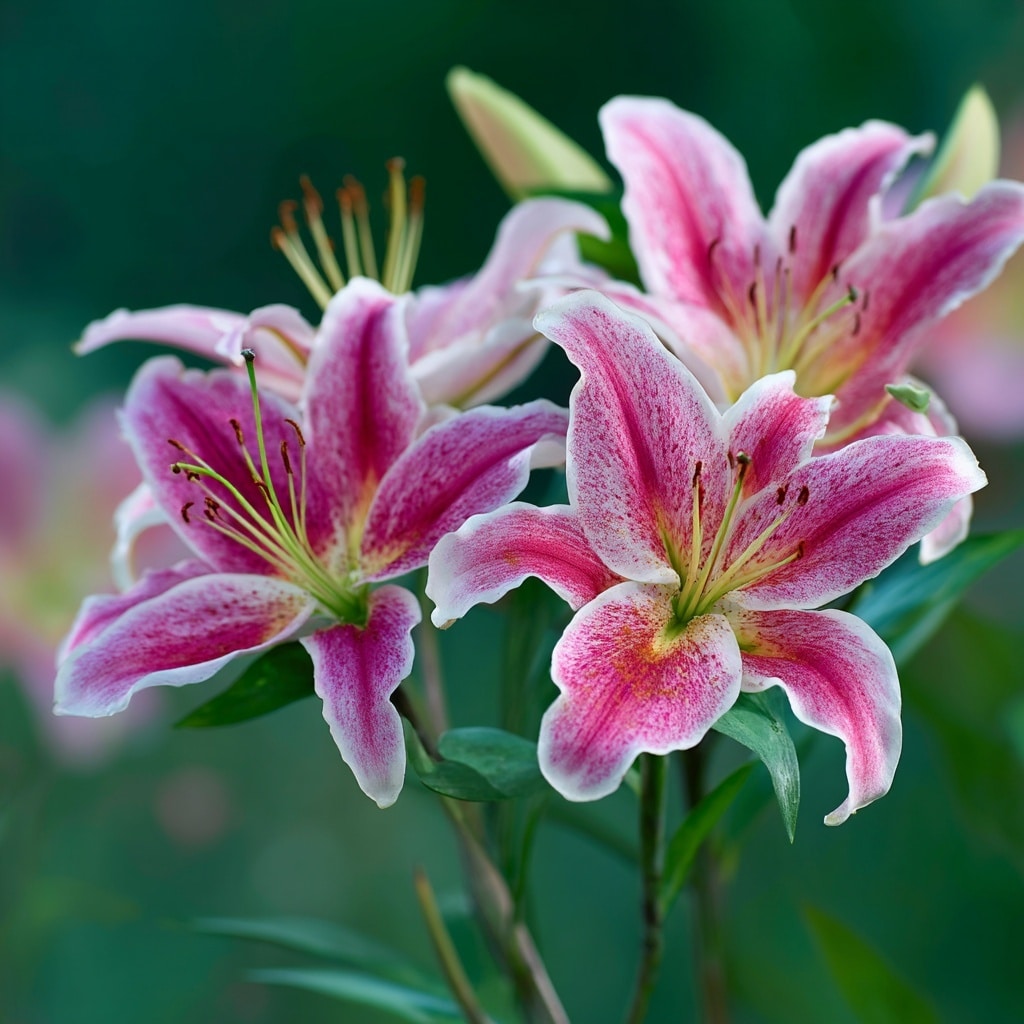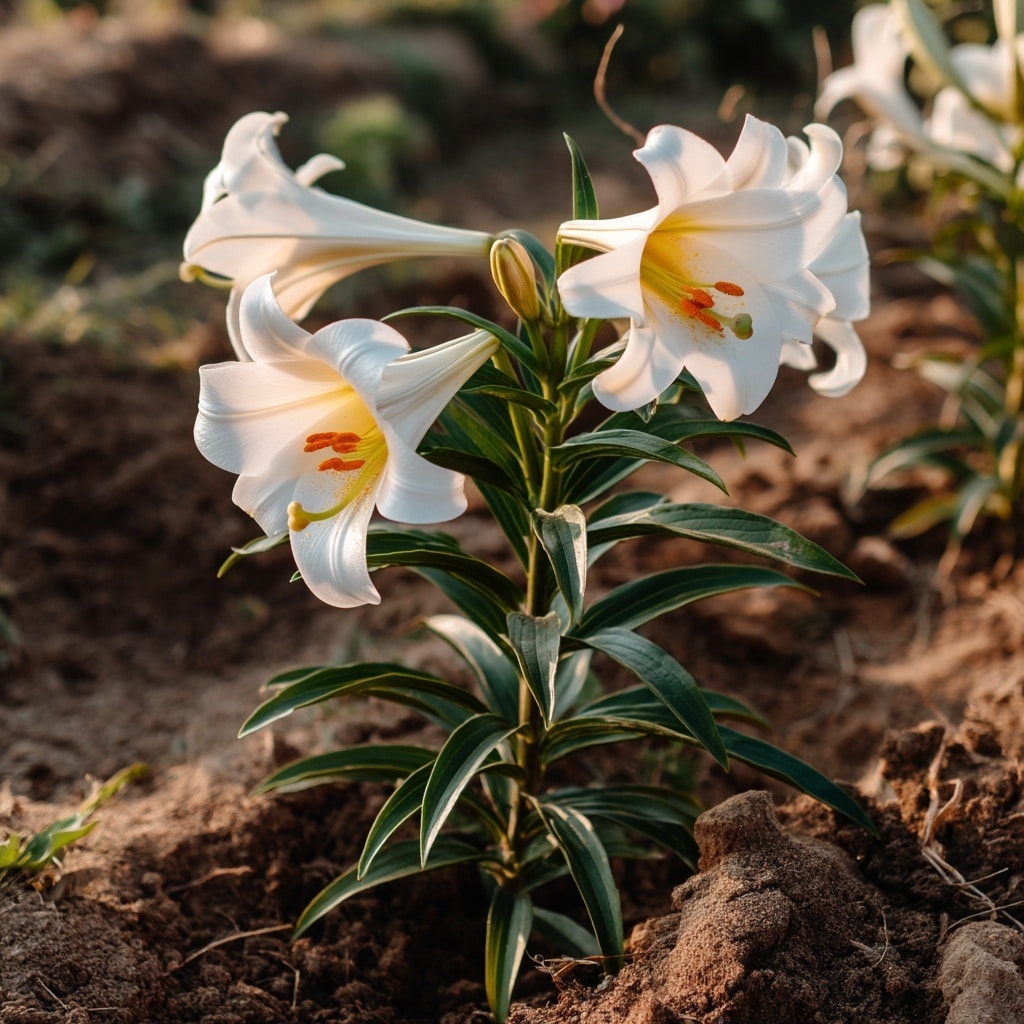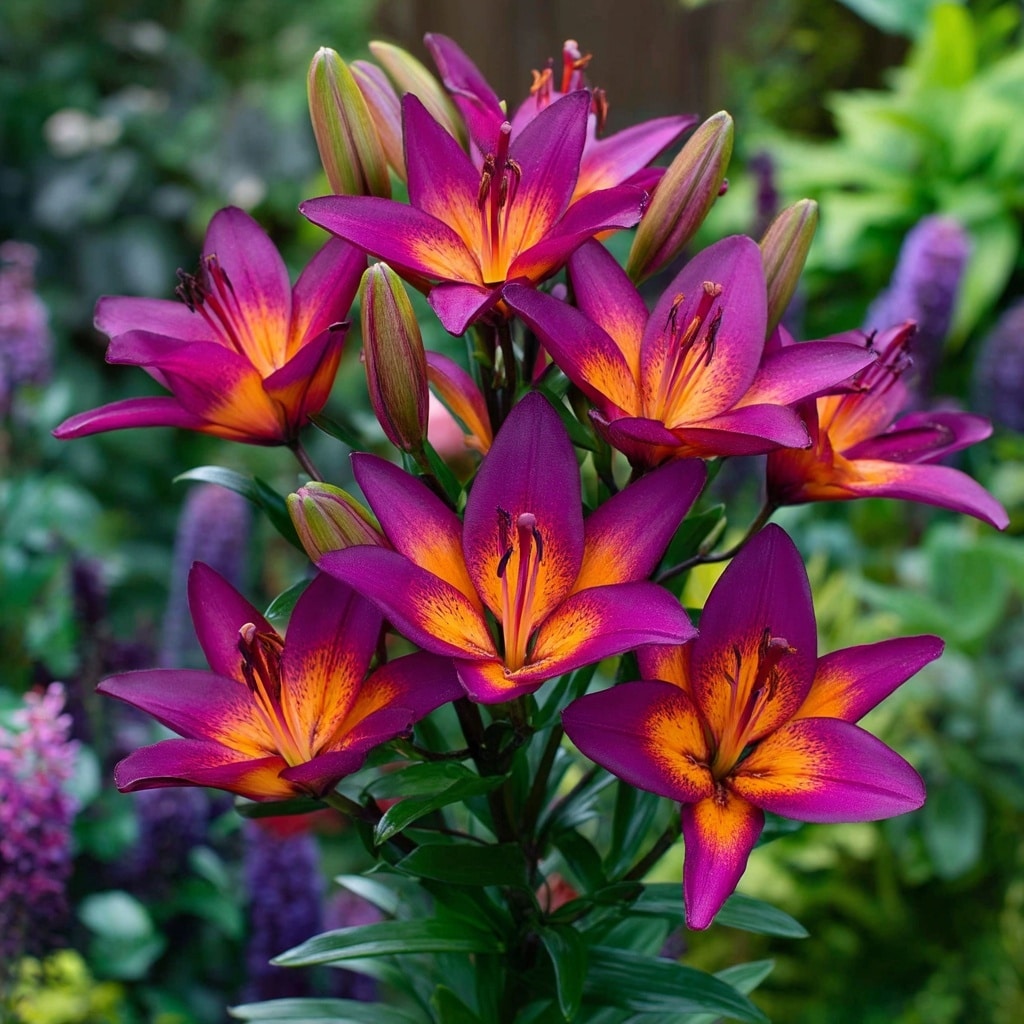Types of lilies for gardens offer some of the most eye-catching and rewarding blooms a gardener can grow. Whether you’re working with a formal landscape or a laid-back cottage bed, lilies provide elegance, vibrant color, and in many cases, delightful fragrance. Their versatility makes them a staple for gardeners who want bold flowers without a lot of fuss.
From the classic Asiatic varieties to the exotic trumpet blooms, there’s a lily type suited for every planting style and skill level. With hundreds of cultivars to choose from, understanding the different types of lilies for gardens can help you select the best varieties for your growing zone, sunlight exposure, and garden design.
In this article, you’ll discover eight standout types of lilies that are not only stunning but also hardy and easy to grow. Whether you’re planting bulbs for the first time or looking to expand your collection, these lilies deserve a spot in your garden plan.
Table of Contents
1. Asiatic Lilies
Among the most popular types of lilies for gardens, Asiatic lilies are known for their brilliant colors, upright growth, and reliability. These early bloomers typically flower in late spring to early summer and are ideal for gardeners looking for a burst of color with minimal effort.
Asiatic lilies feature multiple blooms per stem — often between 3 and 6 — with bold shades of orange, red, yellow, pink, and white. Their petals are often spotted or lightly freckled, adding extra visual texture to flower beds and borders.
Unlike some other lily varieties, Asiatic lilies do not have a strong fragrance, making them a great choice for those sensitive to floral scents. They thrive in full sun and well-drained soil, growing on tall, straight stems that usually don’t require staking.
🐇 Tip: These lilies are highly attractive to deer and rabbits, so consider using deterrents or planting in fenced areas if wildlife is a concern.
Quick Notes:
- Bloom time: Early to mid-summer
- Height: 2 to 4 feet
- Fragrance: None
- Best for: Cut flowers, borders, and beginner gardeners
- Care: Minimal; prefers full sun and well-draining soil
Asiatic lilies are often the first type to bloom in lily beds, setting the tone for a summer full of floral beauty.
2. Oriental Lilies

Oriental lilies are the showstoppers among the types of lilies for gardens — prized for their large, heavily scented blooms and lush foliage. These lilies bloom later in the summer than Asiatic varieties, extending the garden’s flowering season beautifully.
Their flowers can be massive — often the size of a dessert plate — and are available in shades of white, pink, and deep crimson. Many varieties also feature speckled petals or recurved edges, adding elegance and drama to any garden space.
Unlike Asiatics, Oriental lilies are deer and rabbit resistant, and their thick, waxy foliage holds up well throughout the growing season. However, their pollen can stain fabrics, so it’s wise to remove the anthers if you’re cutting them for indoor arrangements.
Their fragrance is strongest in the evening, making them ideal for planting near patios, porches, or pathways where their scent can be enjoyed on summer nights.
Quick Notes:
- Bloom time: Midsummer to late summer
- Height: 2 to 5 feet
- Fragrance: Strong and sweet
- Best for: Scent gardens, moon gardens, cut arrangements
- Care: Needs full sun or part shade, well-drained soil
If you’re planting types of lilies for gardens with fragrance in mind, Oriental lilies are a must-have.
3. Trumpet Lilies

If you’re searching for bold structure and sweet fragrance among the types of lilies for gardens, trumpet lilies are an outstanding choice. Also known as Aurelian lilies, these majestic bloomers live up to their name with long, trumpet-shaped flowers that often face outward or slightly downward.
Trumpet lilies come in classic shades of creamy white, buttery yellow, peach, and pastel pink — often with star-like throats in deeper hues. Some varieties produce more than a dozen blooms per stem, creating a stunning vertical display. One standout cultivar, ‘African Queen’, is known for its towering height and rich orange tones.
These lilies are highly fragrant, making them ideal for sensory gardens or placement near open windows where the scent can waft indoors. Their strong stems and long bloom time add both drama and durability to borders and mixed beds.
Quick Notes:
- Bloom time: Midsummer
- Height: 3 to 6+ feet
- Fragrance: Strong and sweet
- Best for: Tall backdrops, cut flowers, fragrant focal points
- Care: Full sun, well-draining soil, may need staking in windy areas
Among the types of lilies for gardens, trumpet lilies are especially valued for their ability to bring both height and elegance to planting schemes.
4. Orienpet Lilies

Orienpet lilies — a cross between Oriental and Trumpet lilies — combine the best traits of both parents, making them one of the most versatile types of lilies for gardens. They offer the fragrance and flower size of Orientals with the vigor and hardiness of Trumpets.
These lilies produce massive blooms, often 6 to 10 inches wide, with a shallow trumpet shape that opens fully as the flower matures. You’ll find them in glowing shades of yellow, pink, orange, red, and white. The blooms typically face outward, making a big impact whether viewed from a garden path or across the yard.
One of their most appealing traits is their strong fragrance — bold but not overpowering. Orienpets bloom in midsummer and often rebloom later in the season, giving gardeners a second show. With their sturdy stems and heat tolerance, they’re ideal for a wide range of growing zones.
Quick Notes:
- Bloom time: Midsummer with possible rebloom
- Height: 3 to 6 feet
- Fragrance: Rich and noticeable
- Best for: Cutting gardens, large borders, layered beds
- Care: Thrives in full sun, good drainage essential
For gardeners who want reliable performance, stunning size, and lush scent, Orienpet lilies are a standout among the types of lilies for gardens.
5. LA Hybrid Lilies

LA hybrid lilies are a bold and colorful addition to the types of lilies for gardens, bred from a cross between Asiatic lilies and Longiflorum (Easter) lilies. These hybrids take the vivid color range of Asiatics and enhance it with larger blooms and sturdier stems from their Easter lily heritage.
These lilies are typically non-fragrant, which makes them a top choice for gardeners or indoor spaces where strong scents may be too overpowering. The blooms are generous in size — around 6 to 7 inches across — and come in vibrant shades like magenta, coral, crimson, tangerine, and golden yellow.
LA hybrids bloom early to midsummer and can last for weeks. They’re also one of the most popular types for cut flowers, thanks to their long stems, excellent vase life, and pollen that’s less prone to staining.
Quick Notes:
- Bloom time: Early to midsummer
- Height: 3 to 4 feet
- Fragrance: None
- Best for: Modern garden designs, floral arrangements, mass plantings
- Care: Low-maintenance; full sun to part shade
If you’re looking for types of lilies for gardens that provide both bold visuals and easy maintenance, LA hybrid lilies are an unbeatable option.
6. Turk’s Cap Lilies

Turk’s cap lilies — also known as martagon lilies — are instantly recognizable among the types of lilies for gardens thanks to their recurved petals, which curl tightly backward like a turban or “cap.” This whimsical shape, paired with tall stems and dozens of blooms, gives them an elegant, almost wild appearance.
Each stalk can produce up to 20 small, downward-facing flowers that resemble fluttering butterflies. You’ll find Turk’s cap lilies in a range of warm tones, including red, orange, yellow, and pink — often freckled with dark spots.
These lilies are moderately fragrant and bloom in early to midsummer. They prefer cooler climates and are more tolerant of partial shade than most other lilies, making them ideal for woodland edges or dappled garden spots. Their graceful growth habit and natural look are perfect for cottage-style or native garden designs.
Quick Notes:
- Bloom time: Early to midsummer
- Height: 3 to 6 feet
- Fragrance: Light to moderate
- Best for: Woodland gardens, naturalistic borders, tall backdrops
- Care: Prefers partial shade, moist but well-drained soil
As one of the most charming types of lilies for gardens, Turk’s cap varieties bring movement, height, and old-world beauty to any planting scheme.
7. Canada Lilies

Canada lilies (Lilium canadense) are a graceful, native species that stand out among the types of lilies for gardens for their nodding, bell-shaped blooms and ability to tolerate partial shade — a rare trait in lilies. They’re ideal for gardeners who want to include native plants or create a more naturalistic setting.
Each tall, slender stalk produces 5 to 20 drooping flowers in sunny shades of orange or yellow, often with subtly recurved petals. The blooms appear in early to midsummer, swaying gently atop stems that can reach up to 4 feet or more.
These lilies thrive in moist, well-drained soils and work wonderfully in woodland gardens or shaded meadows. However, they are highly attractive to deer and rabbits, so protective netting or repellents may be necessary.
Quick Notes:
- Bloom time: Early to midsummer
- Height: 2 to 4 feet
- Fragrance: Light
- Best for: Natural gardens, shaded beds, native plantings
- Care: Enjoys dappled light; keep soil evenly moist
For those seeking types of lilies for gardens that blend into native landscapes and support pollinators, Canada lilies are a top choice.
8. Longiflorium Lilies (Easter Lilies)

Best known for their role in springtime celebrations, Longiflorium lilies — commonly called Easter lilies — are another classic choice within the many types of lilies for gardens. Though often sold as potted holiday plants, these lilies can be successfully grown outdoors with the right care.
Their trumpet-shaped, pure white flowers are symbolic of renewal and purity, and emit a light, sweet fragrance. Blooming naturally in mid to late summer (though typically forced to bloom for Easter indoors), they reach between 1 and 3 feet in height and produce multiple blooms per stem.
Surprisingly, Easter lilies are quite cold-hardy, tolerating temperatures as low as -20°F. If you receive one as a gift, don’t toss it — plant it in the garden after blooming and, with a bit of patience, it may re-establish and bloom in future years.
Quick Notes:
- Bloom time: Midsummer (when planted outdoors)
- Height: 1 to 3 feet
- Fragrance: Mild and pleasant
- Best for: White-themed gardens, containers, spring bulb borders
- Care: Prefers full sun and loose, well-drained soil
Among the types of lilies for gardens, Longiflorium varieties offer elegance and sentimentality, making them a lovely addition to both formal beds and casual plantings.
How to Plant and Grow Different Types of Lilies for Gardens
Once you’ve chosen your favorite types of lilies for gardens, planting and caring for them properly will ensure strong blooms and long-term success. Luckily, lilies are generally low-maintenance, as long as you follow a few golden rules.
How to Plant Lily Bulbs
- Timing: Plant lily bulbs in early spring or fall. Spring planting is preferred in colder zones.
- Depth: Plant bulbs 3 times as deep as the bulb is tall — typically about 4 to 6 inches.
- Spacing: Allow at least 8 to 12 inches between bulbs to give roots room to spread.
- Orientation: Place bulbs with the pointed end (stem side) up and the root disk facing down.
- Soil: Use well-draining soil; waterlogged beds can cause bulbs to rot.
- Sunlight: Most lilies need 6 to 8 hours of direct sun daily, though Turk’s cap and Canada lilies tolerate partial shade.
💡 Pro Tip: Mix a handful of compost or bone meal into the planting hole for a nutrient boost.
Ongoing Lily Care Tips
- Watering: Water moderately but consistently, especially during dry spells. Avoid soggy conditions.
- Mulching: Apply a 1-inch layer of compost or shredded leaves to retain moisture and suppress weeds.
- Staking: Tall varieties like trumpet and Orienpet lilies may need light staking in windy areas.
- Deadheading: Remove faded blooms to prevent seed formation, which drains energy from the bulb.
- Post-Bloom Care: Allow leaves and stems to die back naturally in fall; don’t cut back green foliage.
Overwintering and Cold Hardiness
Most types of lilies for gardens are hardy to USDA zones 3–8, surviving winter temperatures down to -30°F. In warmer climates (zones 9–11), refrigerate the bulbs for 6–8 weeks before planting to simulate winter dormancy.
Tip: A light application of bulb fertilizer in fall helps develop bigger blooms for next year.
Lilies are not only breathtaking — they’re also resilient. With minimal care, the right varieties will return year after year, rewarding you with unforgettable summer color and fragrance.
Conclusion
Adding different types of lilies for gardens brings both visual drama and long-lasting elegance to any outdoor space. With their variety of colors, bloom shapes, and fragrances, lilies can suit everything from a formal border to a relaxed cottage bed or a shady woodland corner.
Whether you’re drawn to the early blooms of Asiatic lilies, the lush scent of Oriental varieties, or the whimsical charm of Turk’s cap lilies, there’s a lily out there to match your style and growing conditions. Best of all, most types are hardy, low-maintenance, and generous bloomers.
By planting a thoughtful mix of lily types and following the simple care tips above, you’ll enjoy months of striking blooms and a garden filled with beauty, texture, and life






